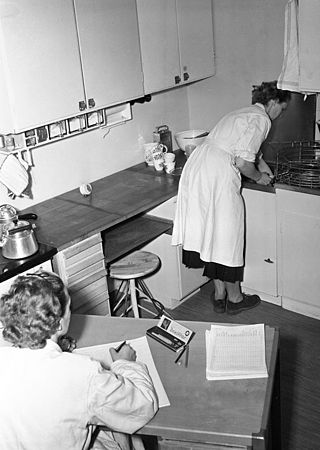
A father is the male parent of a child. Besides the paternal bonds of a father to his children, the father may have a parental, legal, and social relationship with the child that carries with it certain rights and obligations. A biological father is the male genetic contributor to the creation of the infant, through sexual intercourse or sperm donation. A biological father may have legal obligations to a child not raised by him, such as an obligation of monetary support. An adoptive father is a man who has become the child's parent through the legal process of adoption. A putative father is a man whose biological relationship to a child is alleged but has not been established. A stepfather is a non-biological male parent married to a child's preexisting parent, and may form a family unit but generally does not have the legal rights and responsibilities of a parent in relation to the child.
A single parent is a person who has a child or children but does not have a spouse or live-in partner to assist in the upbringing or support of the child. Reasons for becoming a single parent include decease, divorce, break-up, abandonment, becoming widowed, domestic violence, rape, childbirth by a single person or single-person adoption. A single parent family is a family with children that is headed by a single parent.
The fathers' rights movement is a social movement whose members are primarily interested in issues related to family law, including child custody and child support, that affect fathers and their children. Many of its members are fathers who desire to share the parenting of their children equally with their children's mothers—either after divorce or marital separation. The movement includes men as well as women, often the second wives of divorced fathers or other family members of men who have had some engagement with family law.

A housewife is a woman whose role is running or managing her family's home—housekeeping, which may include caring for her children; cleaning and maintaining the home; making, buying and/or mending clothes for the family; buying, cooking, and storing food for the family; buying goods that the family needs for everyday life; partially or solely managing the family budget—and who is not employed outside the home. The male equivalent is the househusband.
Nancy Julia Chodorow is an American sociologist and professor. She began her career as a professor of Women's studies at Wellesley College in 1973, and from 1974 on taught at the University of California, Santa Cruz, until 1986. She then was a professor in the departments of sociology and clinical psychology at the University of California, Berkeley until she resigned in 1986, after which she taught psychiatry at Harvard Medical School/Cambridge Health Alliance. Chodorow is often described as a leader in feminist thought, especially in the realms of psychoanalysis and psychology.

Sociology of the family is a subfield of the subject of sociology, in which researchers and academics study family structure as a social institution and unit of socialization from various sociological perspectives. It can be seen as an example of patterned social relations and group dynamics.

A double burden is the workload of people who work to earn money, but who are also responsible for significant amounts of unpaid domestic labor. This phenomenon is also known as the Second Shift as in Arlie Hochschild's book of the same name. In couples where both partners have paid jobs, women often spend significantly more time than men on household chores and caring work, such as childrearing or caring for sick family members. This outcome is determined in large part by traditional gender roles that have been accepted by society over time. Labor market constraints also play a role in determining who does the bulk of unpaid work.
Mary Dinsmore Ainsworth was an American-Canadian developmental psychologist known for her work in the development of the attachment theory. She designed the strange situation procedure to observe early emotional attachment between a child and their primary caregiver.
A stay-at-home mother is a mother who is the primary caregiver of the children. The male equivalent is the stay-at-home dad. The gender-neutral term is stay-at-home parent. Stay-at-home mom is distinct from a mother taking paid or unpaid parental leave from her job. The stay-at-home mom is forgoing paid employment in order to care for her children by choice or by circumstance. A stay-at-home mother might stay out of the paid workforce for a few months, a few years, or many years.

In the United States, the traditional family structure is considered a family support system involving two married individuals providing care and stability for their biological offspring. However, this two-parent, heterosexual, nuclear family has become less prevalent, and nontraditional family forms have become more common. The family is created at birth and establishes ties across generations. Those generations, the extended family of aunts and uncles, grandparents, and cousins, can hold significant emotional and economic roles for the nuclear family.

Care work is a sub-category of work that includes all tasks that directly involve the care processes done in service of others. It is often differentiated from other forms of work because it is considered to be intrinsically motivated. This perspective defines care labor as labor done out of affection or a sense of responsibility for other people, with no expectation of immediate pecuniary reward. Regardless of motivation, care work includes care activities done for pay as well as those done without remuneration.
Dads for Life (DFL) is a national men's movement in Singapore promoting active fatherhood.
A working parent is a father or a mother who engages in a work life. Contrary to the popular belief that work equates to efforts aside from parents' duties as a childcare provider and homemaker, it is thought that housewives or househusbands count as working parents. The variations of family structures include, but are not limited to, heterosexual couples where the father is the breadwinner and the mother keeps her duties focused within the home, homosexual parents who take on a range of work and home styles, single working mothers, and single working fathers. There are also married parents who are dual-earners, in which both parents provide income to support their family. Throughout the 20th century, family work structures experienced significant changes. This was shown by the range of work opportunities each parent was able to take and was expected to do, to fluctuations in wages, benefits, and time available to spend with children. These family structures sometimes raise much concern about gender inequalities. Within the institution of gender, there are defined gender roles that society expects of mothers and fathers that are reflected by events and expectations in the home and at work.
Work–family balance in the United States differs significantly for families of different social class. This differs from work–life balance: while work–life balance may refer to the health and living issues that arise from work, work–family balance refers specifically to how work and families intersect and influence each other.
Shared earning/shared parenting marriage, also known as peer marriage, is a type of marriage where partners at the outset agree to adhere to a model of shared responsibility for earning money, meeting the needs of children, doing household chores, and taking recreation time in near equal fashion across these four domains. It refers to an intact family formed in the relatively equal earning and parenting style from its initiation. Peer marriage is distinct from shared parenting, as well as the type of equal or co-parenting that father's rights activists in the United States, the United Kingdom and elsewhere seek after a divorce in the case of marriages, or unmarried pregnancies/childbirths, not set up in this fashion at the outset of the relationship or pregnancy.
The motherhood penalty is a term coined by sociologists, that in the workplace, working mothers encounter disadvantages in pay, perceived competence, and benefits relative to childless women. Specifically, women may suffer a per-child wage penalty, resulting in a pay gap between non-mothers and mothers that is larger than the gap between men and women. Mothers may also suffer worse job-site evaluations indicating that they are less committed to their jobs, less dependable, and less authoritative than non-mothers. Thus, mothers may experience disadvantages in terms of hiring, pay, and daily job experience. The motherhood penalty is not limited to one simple cause but can rather be linked to many theories and societal perceptions. However, one prominent theory that can be consistently linked to this penalty is the work-effort theory. It is also based on the mother's intersectionality. There are many effects developed from the motherhood penalty including wage, hiring, and promotion penalties. These effects are not limited to the United States and have been documented in over a dozen other industrialized nations including Japan, South Korea, The United Kingdom, The Netherlands, Poland, and Australia. The penalty has not shown any signs of declining over time.

In 2021, China ranked 48th out of 191 countries on the United Nations Development Programme's Gender Inequality Index (GII). Among the GII components, China's maternal mortality ratio was 32 out of 100,000 live births. In education 58.7 percent of women age 25 and older had completed secondary education, while the counterpart statistic for men was 71.9 percent. Women's labour power participation rate was 63.9 percent, and women held 23.6 percent of seats in the National People's Congress. In 2019, China ranked 39 out of the 162 countries surveyed during the year.

The family structure of African Americans has long been a matter of national public policy interest. A 1965 report by Daniel Patrick Moynihan, known as The Moynihan Report, examined the link between black poverty and family structure. It hypothesized that the destruction of the black nuclear family structure would hinder further progress toward economic and political equality.
The portrayal of parents in media sometimes depicts gender stereotypes in society, often highlighting the "traditional nuclear family" as opposed to nonconventional configurations. Social Scientists have found that home, family, and romance are three of the most important components of the way characters are presented. Moreover, these qualities are often presented in a stereotypical and traditional fashion. In the 1950s the meaning of the word parent coincided with the nuclear family structure—husband, wife, and children. Parents had a responsibility to uphold traditional gender roles in society. Gender roles in society were as follows: fathers work outside of the home and bring in the bread, while mothers tend to housework, make sure they are emotionally available, and look after the children. In today's time, the definition and responsibility of a parent has become more flexible/adjustable since the 1950s, although some parents tend to stick to their traditional gender roles. For example, two-married-parent families were the most common type of family unit a generation ago; however, in the year 2000 that particular family structure could only be found in one out of four households. Because of the shift in parenting, media outlets took it upon themselves to provide representation for certain family structures outside of the nuclear family, leaving them flexible as well. Mass media has presented a multitude of family structures and has promoted the acceptance of alternate family structures in many ways including television, newspapers, movies, commercials, books, comics, etc. Media is linked to the structure of families, given that parents and their children confide in it when questioning their own family and parenting practices. Its influence impacts parents positively and negatively, either by underrepresentation or drawing the perfect picture.

Single parents in the United States have become more common since the second half of the 20th century.









